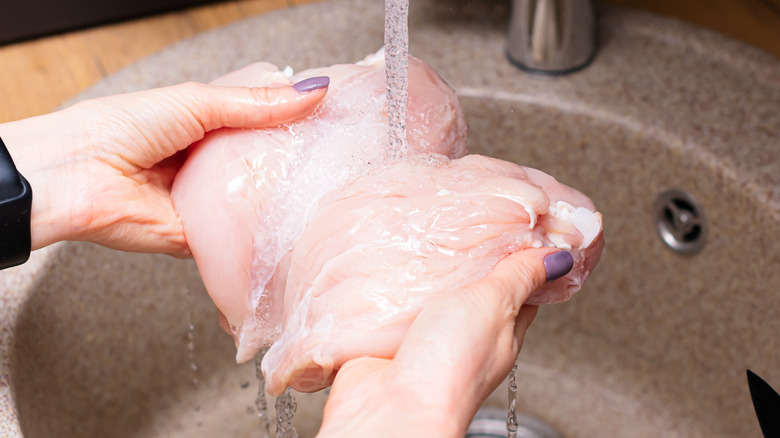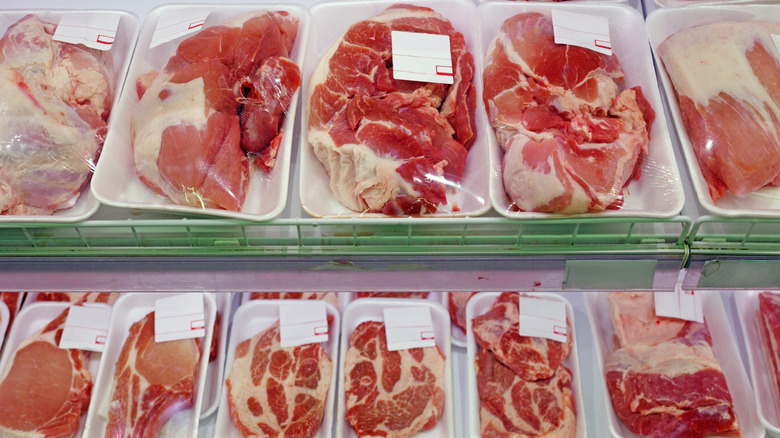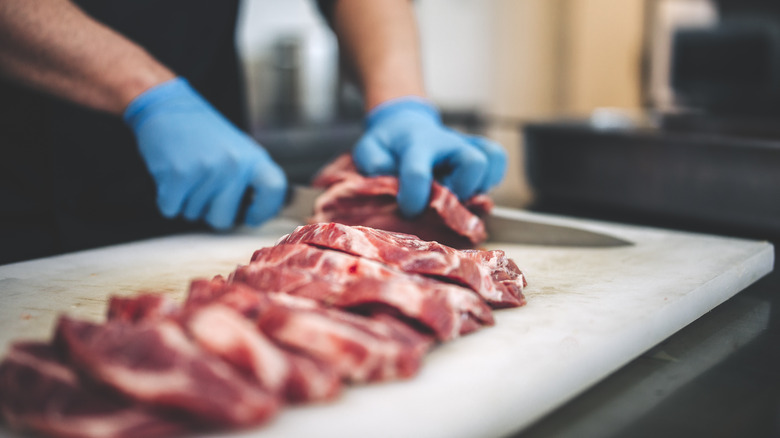Is It Safe To Rinse Meat Before You Cook It?
When it comes to germs, the consensus is that it's better to be safe than sorry. That's why many people have made it a habit to rinse off their meat before cooking it. Given that the CDC recommends washing produce that you bring home, it's not much of a leap to think that raw meat, poultry, and seafood would also need a rinse before consumption. Some clean store-bought meat to remove excess juices, while others do it because that's what they were taught. However, cleaning meat before you eat it is not only unnecessary, it can be counterproductive to keeping bacteria out of the kitchen.
There are a few other reasons why rinsing or washing raw meat isn't worth the hassle. For one thing, meat bought at a grocery store or the local butcher has already been cleaned. The purpose of the styrofoam and plastic trays used to contain raw meat at supermarkets is to keep germs or other foreign substances from coming in contact with the meat, so washing it when you get home is just redundant. Additionally, using anything other than water to clean meat, such as dish detergents will not only impart an unpleasant taste, but if you don't rinse it off completely, you risk ingesting the chemicals, which can lead to serious gastrointestinal issues, according to Healthline.
Rinsing raw meat can lead to cross-contamination
The most pressing reason to avoid rinsing raw meat is that, according to research from the USDA, doing so "increases the risk for cross-contamination in the kitchen, which can cause foodborne illness." This is mostly because when you wash raw meat, poultry, or seafood, it can come into contact with more surfaces than it would if you were to cook it immediately.
Say for example that you wanted to rinse off a chunk of beef to make a steak. While you're focused on washing away any juices or bits of fat in the sink, you may fail to notice the water that has splashed its way onto your counters after being imbued with beefy bacteria. Then, in your rush to get the sirloin on the frying pan, you forget to fully sanitize the sink after it has been covered with raw meat juice. If you were to use a dish towel to wipe down the seemingly innocent water drops on your counter and were to fill the germy sink with dishes, it wouldn't take long before your entire kitchen (not to mention your hands) are contaminated with the bacteria you thought you were rinsing away.
The best way to handle raw meat
To avoid coating your kitchen with bacteria, keep it in whatever package it came in — away from other foods — until it's time to cook. Then, use a separate cutting board and knife to prepare it. You could also wear a pair of food-safe gloves while handling raw meat, but if you do, stay vigilant about what you touch and be sure to dispose of them before dealing with other food. When it's time to clean, wash any tools that have come into contact with raw meat separately with hot, soapy water. You can then sanitize them by running them through the dishwasher, or by using a disinfectant solution. A tablespoon of a standard strength bleach per gallon of water is an appropriate dilution for cleaning surfaces and tools, though it can darken certain metal utensils over time.
As for the meat itself, cooking it to the proper temperature is enough to ensure that it is germ-free and safe enough to eat. Per the CDC, finned fish and red meat like beef, lamb, and pork need to reach an internal temperature of 145 degrees Fahrenheit, ground meat should be at least 160 degrees, and poultry must reach 165 degrees. The most reliable way to check that any food has achieved the proper internal temperature is with a food thermometer. No matter what you're cooking, following food safety guidelines is the key to a delicious and germ-free meal.


